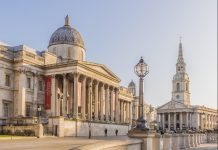Scattered across London in stately prominence and secret corners, the blue plaques scheme brings buildings to life, connecting people and places and providing an emotional engagement with the city’s rich history.
On a quiet Chelsea street between the River Thames and the bustling King’s Road, the odd passer-by pauses to ponder two small blue plaques set into the red-brick walls of numbers 30 and 34. Once home to the composer Philip Arnold Heseltine, who was generally known by his pseudonym ‘Peter Warlock’, and wit and dramatist Oscar Wilde respectively, the circular signs serve as a reminder of these famous names and help us make the imaginative leap that connects us with the past.
Tite Street, as this particular street is called, was a favoured and fashionable location for those of an artistic disposition in the late 19th century and its most notorious resident, Wilde, moved into number 34 in 1884. The house’s plaque, like others all over London, gives us a tangible place to associate with the life of its celebrity occupant.
And it is this that forms the main draw of the capital’s blue plaques. They offer people the opportunity to visualise familiar buildings as they would have been when some of the most influential, innovative, creative or intelligent people in history called them home. Since its inception in 1866, the blue plaque scheme has allowed London locals and visitors to discover where their favourite author, scientist, musician, politician or other well-known name lived or worked.
From grand residences that are open to the public to quirky and hard-to-find boltholes in unlikely locations, there are over 900 iconic blue plaques spread across London, with a few more in other major cities around Britain. Now thought to be the oldest of its kind in the world, the scheme has had several sponsors over the years. The plaques haven’t always been blue – the colours used have ranged from chocolate brown to sea green; for a while, a rectangular bronze design was in favour. The Society of Arts, the London County Council, the GLC (which settled on the existing standardised blue roundel) and, currently, English Heritage have all been responsible for deciding who qualifies for a plaque and what it should look like.
Under the current rules, the person commemorated must have been dead for 20 years or have passed the 100th anniversary of their birthday, have resided in London for a significant amount of time, and deserve national recognition or have made an important contribution to human happiness. There are a few cases where the 100-year rule has been waived, Mahatma Gandhi and Herbert Morrison were allowed plaques almost straight away and others have had their applications refused at least once, including two notorious Sylvias – namely Pankhurst and Plath.
Blue plaques historian Howard Spencer is responsible for researching and presenting potential new blue plaques to an august panel of fair-minded people, recently including Andrew Motion and Stephen Fry, who decide on each plaque that goes up. Most new plaques are nominated by members of the public and the aim is to cover as many areas of human life as possible. From the 100 viable suggestions received every year, however, only 12 are approved, and that figure will probably come down in the future.
Spencer says that the plaques are much loved by Londoners and tourists alike. “They are a very visible means of promoting history and heritage and reminding people that buildings are about more than bricks and mortar – they’re also about the lives of the people that lived in them,” he says. “It’s just interesting to know that certain people were connected with certain areas – it turns people’s heads and is a point of interest.”
London’s oldest surviving blue plaque, erected in 1867, belongs to Napoleon III, who lived just off St James’ Square in the years before he became Emperor. There are also plenty of resident Americans who have been honoured with a plaque. Indeed, the first batch that went up included Benjamin Franklin, whose house in Craven Street, Charing Cross – now the Franklin Museum – was commemorated.
Then there are those famous faces who have moved around so much that they have multiple blue plaques, such as Dickens, Chamberlain and Rossetti. On Essex Street in Covent Garden, the sheer numbers of laudable residents (including Charles Edward Stuart and Samuel Johnson) caused the committee to decide that one rectangular stone plaque would have to accommodate everyone.
And famous names from more recent times are starting to adorn London’s walls. In 2010 Yoko Ono proudly unveiled a plaque at 34 Montagu Square – the first home she shared with legendary popstar, John Lennon. The apartment has multiple Beatles associations. It was bought in 1965 by Ringo Starr – and it was later briefly tenanted by Paul McCartney and Jimi Hendrix.
The depth and diversity of London’s past residents is quite remarkable; from scientists such as Michael Faraday (Blandford Street, Marylebone) and Charles Darwin (University College, Camden) to novelists and playwrights including J M Barrie (Bayswater Road, Westminster) some of the greatest names in history can boast a blue plaque among their many achievements.
Not every blue plaque bears an immediately recognisable name however. Sir Thomas Fowell Buxton, for example, is cited by Spencer as someone many people may not have heard of but who is extremely deserving of his blue plaque. “He was an anti slavery campaigner,” says Spencer, “and while everyone knows William Wilberforce, Buxton took over from him in the early 1820s, so it was actually him who piloted the abolition of slavery itself. I think he’s an unjustly neglected historical figure.” The plaque came about from research connected with the 200th anniversary of the abolition of the slave trade in 2007 and it went up that year on the Old Truman Brewery in Brick Lane.A select few of London’s blue plaque properties are open to the public, including John Keats’ and Sigmund Freud’s houses in Hampstead and the Georgian villa, Ranger’s House, in Greenwich Park, which was once home to Philip, Earl of Chesterfield. Many are now museums and one of the most spectacular is the Leighton Museum in the former home of the Victorian artist Frederic, Lord Leighton.
Located on the edge of Holland Park, an unassuming façade hides a remarkable interior, extended and embellished by Leighton himself over a period of 30 years to become what is now a private palace of art. From the stunning Arab Hall added in 1877, lined with hundreds of tiles from Syria, to the grand studio on the first floor where Leighton painted most of his masterpieces, it is one of London’s hidden gems.
The museum’s curator, Daniel Robbins, says that although Leighton is the only person to have ever lived in the house it wasn’t his intention for it to become a museum. “The tragedy of it is that the collection of objects Leighton amassed – furniture, paintings and so on – were sold immediately after he died and the house was left empty. When it reopened in 1900, it was a long process to buy back as much as possible.”
While the properties bearing blue plaques that are open to the public are few, and certainly Leighton House is unusual in its glorious interior, it’s the private houses that are often just as fascinating to those who walk by. The joy of them is to imagine these people in familiar places as you walk past – to see George Orwell creating his totalitarian world of Big Brother from an unassuming house in Camden for example, or Ivor Novello composing some show-stopping classics in a top floor flat above the Strand Theatre where he lived for 38 years.
Winston Churchill famously said: “We shape our buildings, and afterwards our buildings shape us”. It’s easy to imagine him flashing his familiar victory sign from the window of the residence where his blue plaque now sits at 28 Hyde Park Gate. The innocuous plaques remind us that these historical heavyweights were there, and enable us to imagine our own vision of their London lives.





 © 2024
© 2024